Shoulder pain can creep up on you. Bad posture, heavy overhead lifting or repetitive movements can wreak havoc on this highly mobile joint.
Over time, simple muscle soreness can turn into chronic pain. Without proper care, a sore shoulder can turn into an injury.
This can all be avoided. Stop stretching, grab your tennis ball and let’s start this must read lesson.
Simple Anatomy
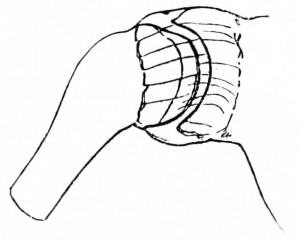 The shoulder is a ball and socket joint, which means it is super mobile. This you already know since you can make movements every which way with your arm.
The shoulder is a ball and socket joint, which means it is super mobile. This you already know since you can make movements every which way with your arm.
A high level of mobility comes at a cost.
Low stability.
The ligaments, tendons and muscles surrounding the joint each have their own job to do to keep your shoulder in it’s socket, let alone support some pretty crazy movements.
 With the stress and strain of bad posture, a simple ‘bad movement’ where you overload the muscles, or by performing too much repetitive stuff, you can find yourself with a very tight shoulder.
With the stress and strain of bad posture, a simple ‘bad movement’ where you overload the muscles, or by performing too much repetitive stuff, you can find yourself with a very tight shoulder.
Trigger points develop and that bad posture gets worse while you are trying to compensate for the tightness and consequent weakness.
You can see how you can quickly end up with some pretty serious injuries.
Luckily, I can solve your problems right here with a simple tennis ball.
Note: These are very common areas that cause pain. Not all of them will be tight and aggravated in your case, try them all out and find out what elicits the pain again, what gives you the most release and what simply doesn’t need work. Once you know, hammer it until it feels better.
Believe me, it will feel better.
1. Infraspinatus and Teres Minor
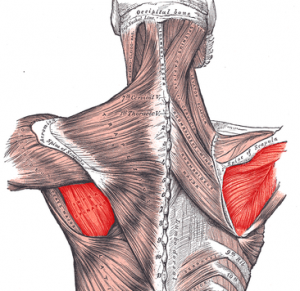
Why
These are two very important rotator cuff muscles and they are used to stabilise your shoulder during everyday movements. People will bad posture and rounded shoulder are especially susceptible to tightness in this area.
Overhead athletes need to be particularly aware of these muscles as they are a common site of soreness and tight trigger points.
Tight and aggravated infraspinatus and teres minors don’t necessarily cause shoulder pain (although they often do), however they have a huge effect on the biomechanics of your shoulder and are often an underlying factor in chronic and acute shoulder injuries.
How
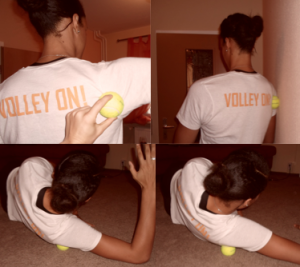 You can best access this area lying on your side. Place the ball in the area just outside of your shoulder blade, and bend your elbow at 90 degrees.
You can best access this area lying on your side. Place the ball in the area just outside of your shoulder blade, and bend your elbow at 90 degrees.
For people with tightness in this area this will feel exceptionally painful and can often refer pain down to the fingers. Once you find a good spot, you can bend your arm forward keeping your elbow bend at 90 degrees. This will help you to get a deeper release.
You can work up and down the length of the muscle, and you simply need to explore the area.
Check out the video below for a more detailed explanation.
2. Latisimuss Dorsi

Why
Although a lot of people wouldn’t attribute the Latisimuss Dorsi to shoulder pain, in my personal experience it is a huge factor.
As you can see from the anatomy picture, you can see how the lats attach, onto various parts of your vertebrae, your scapula (shoulder blades) and into your shoulder. Considering how big the muscle actually is, it’s not a surprise that it can wreak havoc on your shoulder.
When you have tight lats, you will have excessive internal rotation, which can lead to imbalances and impingement.
Not only that your lats have a part in controlling your scapula, which is absolutely crucial to shoulder health.
How
Finding your lats is best done in a similar fashion to the infraspinatus and teres minor, lying on the floor. You need to place the ball lower down your body, but the principal remains the same. Check out this great video below from functional patterns which shows you how to work with a lacrosse ball.
3. Pec Major & Minor

Why
Your pecs are your chest muscles, and consist of the pec major and the pec minor. When we sit with rounded shoulders, or perform a lot of internal rotation these muscles can get quite tight.
Not only can trigger points develop in the muscle which will refer pain into the shoulder, but they can also internally rotate the shoulder even more.
This causes tightness in other muscles and can lead to impingement and various pain syndromes.
How
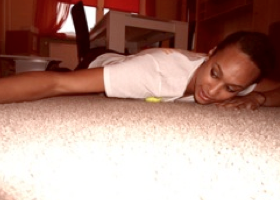 You have to get down and dirty to release the pec muscles. Lie face down on the floor, place the ball anywhere under your chest muscles and get to it.
You have to get down and dirty to release the pec muscles. Lie face down on the floor, place the ball anywhere under your chest muscles and get to it.
Move around slowly until you find a sweet spot. Hang around there and you will eventually feel a release. If you don’t like your floor you can also do this up against a wall.
Keep in mind that the Pec minor is a smaller muscle underneath the major. Trigger points and tightness in this muscle cause just as much trouble, if not more. Make sure you really get into the attachment right near the shoulder for the best results.
4. Trapezius

Why
Although the upper trapezius muscles are often blamed for shoulder and neck pain, they are not the sole contributor.
Tight trapezius muscles are often the by product of other tight areas or muscles imbalances, however it won’t hurt you to release these little lumps. When they get tight and full of trigger points, not only will you feel pain in your shoulder, but you will be more susceptible to neck pain and headaches as well.
The upper traps lie on either side of your neck, but the muscle itself runs right down your back.
How
There are a couple of ways to hit this muscle, but I find the most effective strategy is on the floor. The most common site of trigger points in the traps are on the two bulges on the side of your neck.
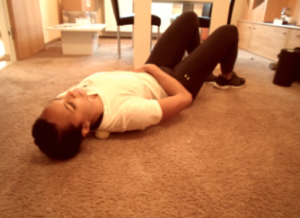 Lie on the floor and place the tennis ball below one of them. The pressure coming up through the ball should be enough to get a good release. You can also press up with your feet to change the angle of attack.
Lie on the floor and place the tennis ball below one of them. The pressure coming up through the ball should be enough to get a good release. You can also press up with your feet to change the angle of attack.
You should move around to find tight areas, and when you get a particularly painful one just hang around on it for a while until you feel it release. Check out this article on upper body tennis ball massage for more pictures and strategies for the traps.
5. Levator Scapula
Why
This annoying little muscle will cause you more problems than you will ever believe.
Have you felt that nagging pain in your shoulder that you can’t seem to stretch out? What about that area that you can’t pinpoint that gets sore after sitting down with bad posture all day. Chances are your levator scapula are hating on you.
This small muscle attaches from your cervical spine onto your shoulder blade. It does a lot of work during the day elevating your shoulder blade, particularly when you are bent over a computer.
How
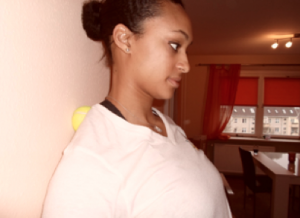 The simplest way to get good pressure on this muscle is by leaning against a wall. Place the ball right at the top corner of your shoulder blade and use that as a starting position.
The simplest way to get good pressure on this muscle is by leaning against a wall. Place the ball right at the top corner of your shoulder blade and use that as a starting position.
In this position you are able to really attack the muscle from above and place the most pressure on the area. You will absolutely know when you hit the spot, and the pain will simulate that nagging ache you often have in your neck or shoulders.
To get an extra stretch on the muscle you can slowly raise your arm. This will work the levator scap and take your through a painful range of motion!
These are just a few simple ways to release your body and get pain free. If you got some results from this (and you should) head over and check out The Ultimate Self Massage Guide. It is an in depth guide that teaches you to release your whole body with a tennis ball and foam roller. If you want a simpler and cheaper five into the world of tennis ball massage, I also have a 99 cent book on kindle that will show you how to use a tennis ball on your whole body! Click here to check it out on amazon.
Another big shout out to Kris over at Dozier Performance (your stop for everything Volleyball) for the cool pics.
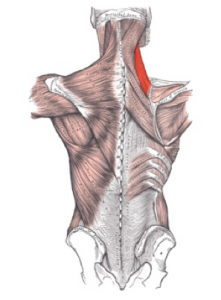
Ingar says
Great stuff, Lauren!
Arwinder says
Hey thanks for the great article. Do you have anything about rotator cuff rehab?
Melissa Kelley says
Hello
My Name is Melissa Kelley and I invented backwisemassage. We are a local business in East Wenatchee Washington and have invented a backmassager for people to use that is easy to use and isn’t electric. We have sold over 500 in just two years and feel we are ready to launch our product throughout the United States.
http://pressreleaseleader.com/pressrelease/30343.html
—
Melissa Kelley
Founder/CEO
BackWise
Give BackWise Massage a try to roll out your stubborn knots!
http://www.BackWiseMassage.com
Steffan Marley says
Lauren,
These are all great exercises! I have shoulder impingement on both sides and by releasing shoulder and pec muscles, the impingement is a non-issue.
Question- will I have to continue with these exercises from here on out or will my shoulders and pecs start to take on a more correct, pain-free position over time (and thereby negating the need for the pre-workout ball roll)?
Thanks!